
Normally when one thinks of coats-of-arms, our vision is the grand, large, and fierce, such as lions or dragons. However, insects, arthropods, and land crustaceans made their way into medieval heraldry as well, often in canting arms. I deliberately titled this article using the word "bugs" not to be inclusive, but rather to emphasize the medieval scribe's viewpoint that all these creatures were "whatsoever goeth upon the belly, and whatsoever goeth upon all four, or whatsoever hath more feet among all creeping things that creep upon the earth" (Leviticus 11:42). We see this reflected in the artwork, where the medieval artist seems to have no regard at all for the number of legs,. Creatures that we class as insects can have the normal six legs, or four, or eight, or more. Arthropods similarly could have any number of legs. There was a class of "creepy-crawlies" in the medieval mindset, and "bugs" is as good a name as any for these creatures.

A note to readers: If you happen to know of additional examples of bugs in medieval heraldry not mentioned here, please drop me a note and tell me about it!
"By the Emmet or Pismier may be signified a man of great labour, wisdome and providence, in all his affaires, and of a pregnant and ready memory." — John Guillim, A Display of Heraldry, 1611
Ants are insects of the family Formicidae. The modern term "ant" evolved from Old English, which eventually gave us Middle English emmet. Another early English word for "ant" is pismire, from the strong ammonia smell of ant-hills. Canting armory using ants can be based on any of these terms. The default orientation for ants is tergiant.
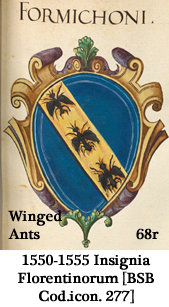 |
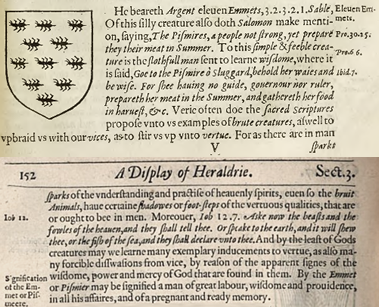 |
|
| Azure, on a bend Or, three winged ants sable. Canting arms of Formichoni. |
Argent semy of emmets fesswise sable. John Guillim, A Display of Heraldry, 1611 |
Or, a bend azure fleury Or between two emmets bendwise sable. Canting arms of Simone di Lorenzo Agnolo Formiconi, 1622 |
"The Bee (saith the wiseman) is the least of Birds, but shee is of much vertue; and shee provideth both Hony for pleasure, and Waxe for thrift.... Bees have three properties of the best kinds of subjects, they sticke close to their King; they are very industrious for their liveli-hood, expelling all idle drones; they wil not sting any but such as first provoke them, and then they are most fierce. — John Guillim, A Display of Heraldry, 1611
Bees are often used in canting arms based on the term for "bee" in various languages, such as Latin apis, French abeille, German Biene, etc., and also on terms for "honey", including Latin mella, French or Spanish miel, Italian miele, German Honig.
The default orientation for bees is tergiant, sometimes also called volant en arrière. Beehives also appear in armory, and they may be surrounded by a swarm of bees in various attitudes, which is termed a beehive beset with bees
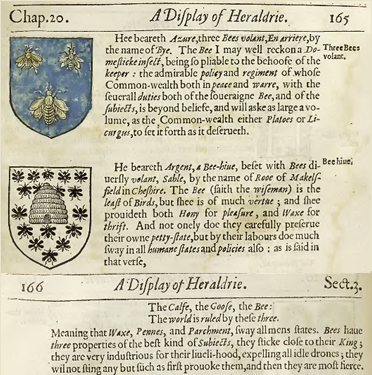 |
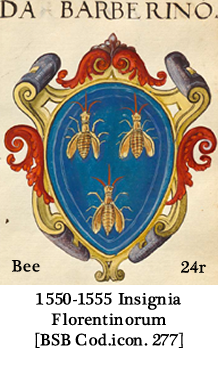 |
| Azure, three bees Or. Argent semy of bees, a beehive sable.. John Guillim, A Display of Heraldry, 1611 |
Azure, three bees Or. De Barbarino. |
The default orientation for beetles is tergiant.
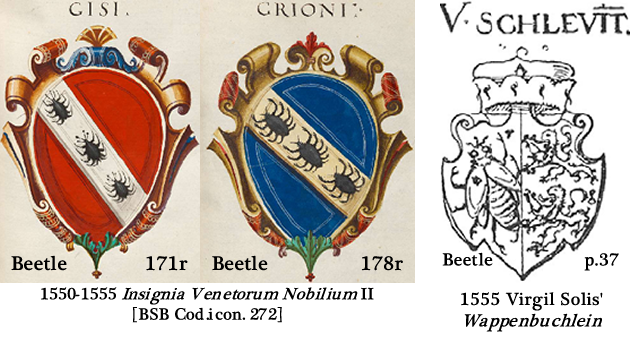 |
||
| Gules, on a bend argent three beetles sable. Gisi |
Azure, on a bend Or three beetles sable. Grioni |
Gules, a beetle bendwise argent impaled with Or, in pale two lions azure(?). Von Schlevit |
Scarabs
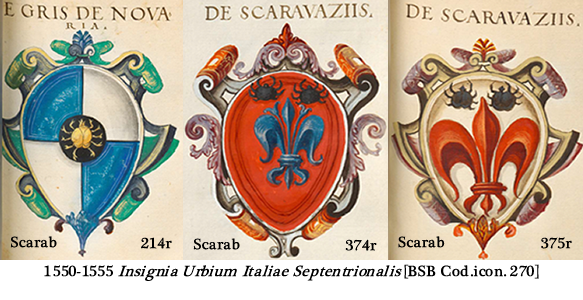 |
||
| Quarterly azure and argent, on a roundel sable a scarab Or. De Gris de Novaria |
Gules,a fleur-de-lys azure and in chief two scarabs sable. Canting arms of De Scaravaziis |
Argent, a fleur-de-lys gules and in chief two scarabs sable. Canting arms of De Scaravaziis |
Stag-Beetles
The stag-beetle, Lucanus cervus, was known in Germany as Schröter since the Early New High German period (modern Hirschkäfer). The word goes back to Old High German scrotan and Middle High German schroten. These verbs originally had the meaning of "(decomposed)-hewn, cut and cropped" in Middle High German. The name refers to the feeding activity and gnawing of the larvae of these beetles. Schröter is also found as a surname punning on the butcher's job title Schneider, "cutter". All of these terms can lead to cants using the stag-beetle (Schimitschek, "Insekten in der Wappenkunde", p. 50). Cants are also made on the English term, "stag-beetle", for names in Hart- or other deer-related surnames.
European folklore also associated stag-beetles with house fires, calling them Feuerschröter "fire-beetle", Börner or Brenner "burner", or even Teufelspferd "the devil's horse", because stag-beetles live and breed in rotting wood and trees, which might be struck by lightning, and these concepts might also come in handy in constructing canting arms (Schimitschek, "Insekten in der Wappenkunde", pp. 49–50).
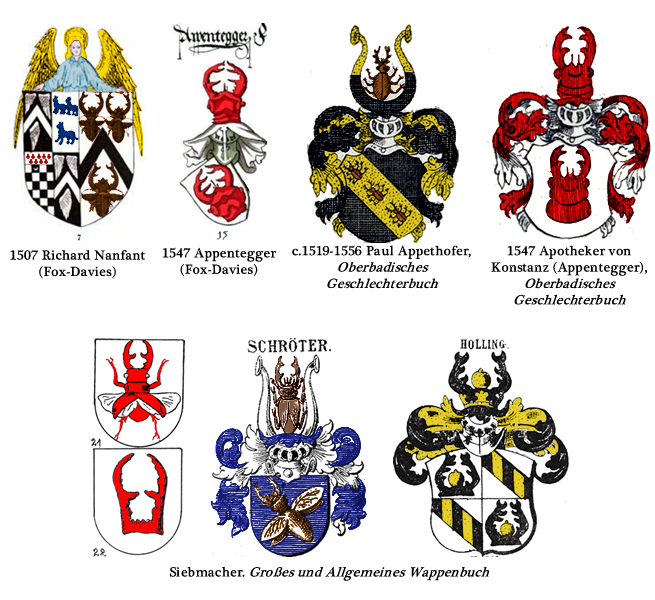 | |
|
Nanfant: Quarterly, 1 and 4, Sable, a chevron between three wings inverted argent; 2. Argent, three wolves azure; 4. Checky argent and sable, a chief argent gutte-de-sang, a crescent for difference; impaling Argent, a chevron sable between three stag-beetles volant en arrière proper. Fox-Davies. The Art of Heraldry. Plate LV, Fig. 7 and p. 301. Appentegger: Argent, a stag-beetle's head couped gules. Fox-Davies. The Art of Heraldry. Plate XCVIII, Fig. 15 and p. 426. Appethofer: Sable, on a bend Or three stag-beetles proper. Von Knobloch, Oberbadisches Geschlechterbuch. Vol. 1, p. 19. Apotheker: Argent, a stag-beetle's head couped gules. Von Knobloch, Oberbadisches Geschlechterbuch. Vol. 1, p. 18. |
Argent, a stag-beetle volant en arrière gules. Siebmacher. Großes und Allgemeines Wappenbuch. p. 96 and Plate XXI, Fig. 21. Argent, a stag-beetle's attires couped gules. Siebmacher. Großes und Allgemeines Wappenbuch. p. 96 and Plate XXI, Fig. 22. Schröder. Azure, a stag-beetle volant en arrière bendwise proper. Siebmacher. Großes und Allgemeines Wappenbuch. Introduction, Part B, p. 47, Plate 53. 1673 Holling. Quarterly, 1 and 4, Argent, within the attires of a stag-beetle couped sable an apple Or; 2 and 3 Argent, a bend paly sable and Or. Siebmacher. Großes und Allgemeines Wappenbuch. Vol. 3, No. 1, p. 46, Plate 59. |
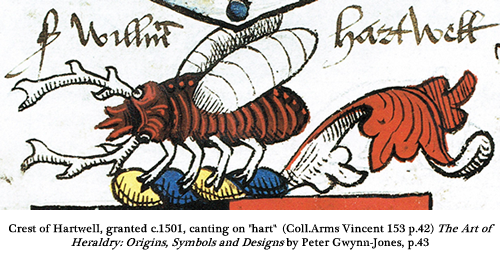 |
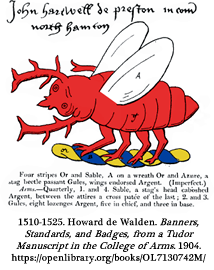 |
| A stag-beetle passant gules, wings addorsed, attired and legged argent. Gwynn-Jones. The Art of Heraldry. p. 43. |
A stag-beetle passant gules, wings addorsed argent. de Walden. Banners, Standards, and Badges. p. 217. |
The default orientation for butterflies and moths is tergiant, sometimes also called volant en arrière. Sometimes butterflies are shown with two pairs of wings, or with bat-like veined wings. Moths tend to be depicted with two wings.
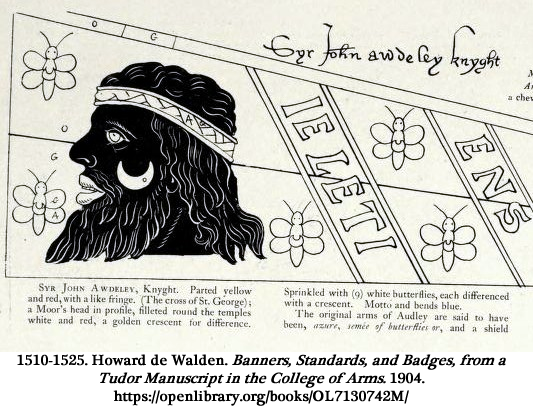 |
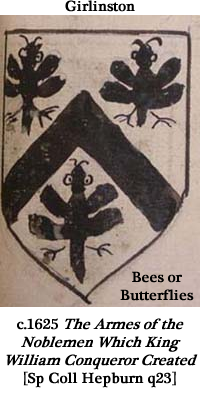 |
| A semy of butterflies argent. Banner of Sir John Awdeley |
Argent, a chevron between three butterflies(?) sable. Arms of Girlinston |
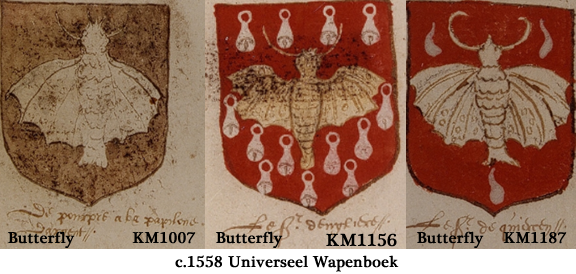 |
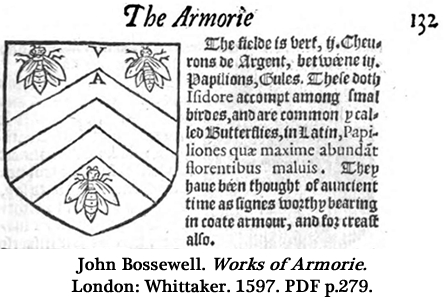 |
| (Left) Sable, a butterfly argent. (Center) Gules semy of bells argent, a butterfly Or. (Right) Gules, a butterfly between three gouttes argent. The text of KM1007 specifically calls this a papilone or butterfly. |
Vert, two chevronelles argent between three butterflies gules. Bossewell names these papilions, though they resemble bees. |
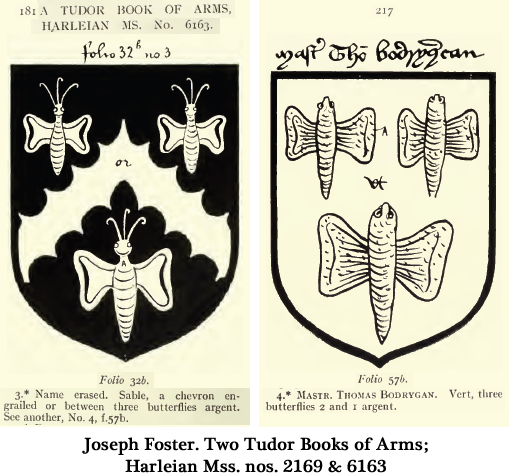 |
| (Left) Sable, a chevron engrailed Or between three butterflies argent. (Right) Vert, three butterflies argent. |
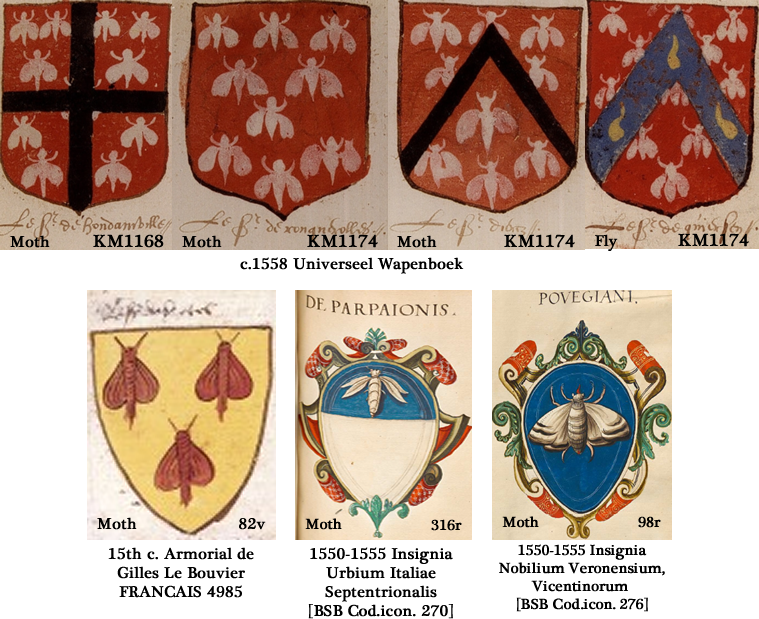 |
| (Top Row) KM1168 Gules semy of moths argent, a cross sable. KM1174 Gules semy of moths argent. KM1174 Gules semy of moths argent, a chevron sable. KM1174 Gules semy of moths argent, on a chevron azure three gouttes Or. (Bottom Row) (Left) Or, three moths gules. (Center) Argent, on a chief azure a moth(?) argent. (Right) Azure, a moth argent. |
The default orientation for cicadas is tergiant, sometimes also called volant en arrière. Guillim shows a cicada under the name of "harvest fly".
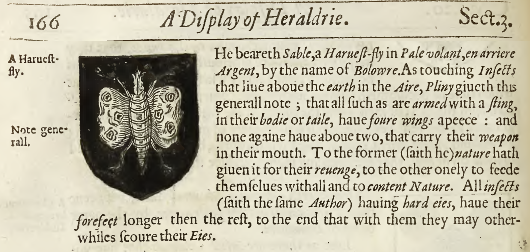 |
| Sable, a cicada argent. John Guillim, A Display of Heraldry, 1611 |
The default orientation for dragonflies is tergiant, sometimes also called volant en arrière.
| Blazon. Text |
Blazon. Text |
Blazon. Text |
The default orientation for fleas is tergiant.
| Blazon. Text |
Blazon. Text |
Blazon. Text |
The default orientation for flies is tergiant, sometimes also called volant en arrière.
| Blazon. Text |
Blazon. Text |
Blazon. Text |
The default orientation for grasshoppers and crickets is passant.
| Blazon. Text |
Blazon. Text |
Blazon. Text |
The default orientation for wasps and hornets is tergiant, sometimes also called volant en arrière.
| Blazon. Text |
Blazon. Text |
Blazon. Text |
The default orientation for scorpions is tergiant.
| Blazon. Text |
Blazon. Text |
Blazon. Text |
The default orientation for spiders is tergiant.
| Blazon. Text |
Blazon. Text |
Blazon. Text |
The default orientation for sowbugs or woodlice is tergiant.
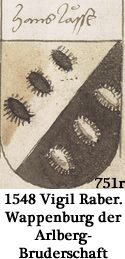 |
||
| Per bend sinister argent and sable, two rows of three woodlice in bend sinister bendwise counterchanged.. |
Blazon. Text |
Blazon. Text |
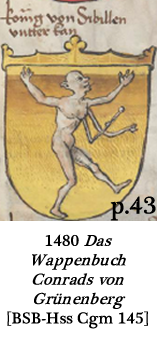 |
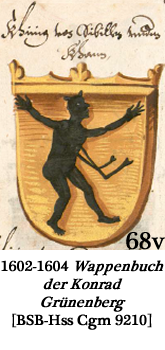 |
| Or, a man passant contourney with two insect legs issuant from his sinister armpit proper. King of "Sibillen Undern Kan" |
Or, a horned man (devil) contourny with two insect legs issuant from his sinister torso sable. King of "Sibillen Undern Kan" |